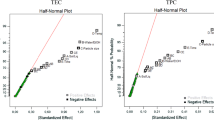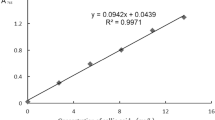Abstract
Microwave-assisted extraction (MAE) was optimized by response surface methodology in order to enhance the extraction of polyphenols from basil (Ocimum basilicum L). Box–Behnken experimental design on three levels and three variables was used for optimization. Influence of ethanol concentration (50, 70, and 90%); microwave power (400, 600, and 800 W); and extraction time (15, 25, and 35 min) on each response were investigated. Experimental results were fitted to a second-order polynomial model, and multiple regression analysis and analysis of variance were used to evaluate model fitness and optimal conditions. Considering the maximum content of extracted total phenols, total flavonoids, and antioxidant activity, the optimal conditions for all investigated response were ethanol concentration of 50%, microwave power of 442 W, and extraction time of 15 min. Under the optimal conditions, obtained basil liquid extract contained 4.299 g gallic acid equivalents/100 g dry weight (DW) of total polyphenols, 0.849 g catechin equivalents/100 g DW of total flavonoids, and IC50 and EC50 values of 9.602 and 82.889 μg/mL, respectively. The development of simultaneous MAE procedure for extraction of total phenols, total flavonoids, and potential antioxidants from basil, represented valorization of basil as valuable source of bioactive compounds.




Similar content being viewed by others
References
Albayrak S, Aksoy A, Albayrak S, Sagdic O (2013) In vitro antioxidant activity of some Lamiaceae species. Iran J Sci Technol A1:1–9
Baş D, Boyacı İH (2007) Modeling and optimization I: usability of response surface methodology. J Food Eng 78:836–845
Bezerra MA, Santelli RE, Oliveira EP, Villar LS, Escaleira LA (2008) Response surface methodology (RSM) as a tool for optimization in analytical chemistry. Talanta 76:965–977
Bouras M, Chadni M, Barba FJ, Grimi N, Bals O, Vorobiev E (2015) Optimization of microwave-assisted extraction of polyphenols from Quercus bark. Ind Crop Prod 77:590–601
Box GEP, Behnken DW (1960) Some new three level design for the study of quantitative variables. Technometrics 2:455–475
Carocho M, Barros L, Barreira JCM, Calhelha RC, Soković M, Fernández-Ruiz V, Buelga CS, Morales P, Ferreira ICFR (2016) Basil as functional and preserving ingredient in “Serra da Estrela” cheese. Food Chem 207:51–59
Chan CH, Yusoff R, Ngoh GC, Kung FWL (2011) Microwave-assisted extractions of active ingredients from plants. J Chromatogr A 1218:6213–6225
Derringer G (1980) Simultaneous optimization of several response variables. J Qual Technol 12:214–219
Do QD, Angkawijaya AE, Tran-Nguyen PL, Huynh LH, Soetaredjo FE, Ismadji S, Ju YH (2014) Effect of extraction solvent on total phenol content, total flavonoid content and antioxidant activity of Limnophila aromatica. J Food Drag Anal 22:296–302
Espin JC, Soler-Rivas C, Wichers HJ (2000) Characterization of the total free radical scavenger capacity of vegetable oils and oil fractions using 2,2-diphenyl-1-picrylhydrazyl radical. J Agric Food Chem 48:648–656
Filip S, Vidović S, Vladić J, Pavlić B, Adamović D, Zeković Z (2016) Chemical composition and antioxidant properties of Ocimum basilicum L. extracts obtained by supercritical carbon dioxide extraction: drug exhausting method. J Supercrit Fluids 109:20–25
Filly A, Fernandez X, Minuti M, Visinoni F, Cravotto G, Chemat F (2014) Solvent-free microwave extraction of essential oil from aromatic herbs: from laboratory to pilot and industrial scale. Food Chem 150:193–198
Flanigan PM, Niemeyer ED (2014) Effect of cultivar on phenolic levels, anthocyanin composition, and antioxidant properties in purple basil (Ocimum basilicum L.). Food Chem 164:518–526
Gil-Chavez GJ, Villa JA, Ayala-Zavala F, Heredia JB, Sepulveda D, Yahia EM, Gonzales-Aguilar GA (2013) Technologies for extraction and production of bioactive compounds to be used as nutraceuticals and food ingredients: an overview. Compr. Rev. Food Sci Food Safety 12:5–23
Grayer RJ, Kite GC, Veitch NC, Eckert MR, Marin PD, Senanayake P, Paton AJ (2002) Leaf flavonoid glycosides as chemosystematic characters in Ocimum. Biochem Syst Ecol 30:327–342
Harborne JB (1984) Methods of plant analysis. Springer, Dordrecht, pp 1–36
Izadiyan P, Hemmateenejad B (2016) Multi-response optimization of factors affecting ultrasonic assisted extraction from Iranian basil using central composite design. Food Chem 190:864–890
Javanmardi J, Khalighi A, Kashi A, Bais HP, Vivanco JM (2002) Chemical characterization of basil (Ocimum basilicum L.) found in local accessions and use in traditional medicines in Iran. J Agric Food Chem 50:5878–5883
Jayasinghe C, Gotoh N, Aoki T, Wada S (2003) Phenolics composition and antioxidant activity of sweet basil (Ocimum basilicum L.). J Agric Food Chem 51:4442–4449
Juliani HR, Simon JE (2002) Antioxidant activity of basil. Trends in new crops and new uses. Janick, J.and Whipkey, A. (eds.), ASHS Press, Alexandria, VA, pp. 575–579.
Kähkönen MP, Hopia AI, Vuorela HJ, Rauha JP, Pihlaja K, Kujala TS, Heinonen M (1999) Antioxidant activity of plant extracts containing phenolic compounds. J Agric Food Chem 47:3954–3962
Kaurinović B, Popović M, Vlaisavljević S, Trivić S (2011) Antioxidant capacity of Ocimum basilicum L. and Origanum vulgare L. extracts. Molecules 16:7401–7414
Keita SM, Vincent C, Schmit JP, Ramaswamy S, Belanger A (2000) Effect of various essential oils on Callosobruchus maculatus (F.) (Coleoptera: Bruchidae). J Stored Prod Res 36(4):355–364
Kwee EM, Niemeyer ED (2011) Variations in phenolic compositions and antioxidant properties among 15 basil (Ocimum basilicum L.) cultivars. Food Chem 128:1044–1050
Lee J, Scagel CF (2009) Chicoric acid found in basil (Ocimum basilicum L.) leaves. Food Chem 115:650–656
Milutinović M, Radovanović N, Ćorović M, Šiler-Marinković S, Rajlić-Stojanović M, Dimitrijević-Branković S (2015) Optimisation of microwave-assisted extraction parameters for antioxidants from waste Achillea millefolim dust. Ind Crop Prod 77:333–341
Milutinović M, Radovanović N, Rajlić-Stojanović M, Šiler-Marinković S, Dimitrijević S, Dimitrijević-Branković S (2014) Microwave-assisted extraction for the recovery of antioxidants from waste Equisetum arvense. Ind Crop Prod 61:388–397
Msaada K, Jemia MB, Salem N, Bachrouch O, Sriti J, Tammar S, Bettaieb I, Jabri O, Kefi S, Limam F, Marzouk B (2014) Antioxidant activity of methanolic extracts from three coriander (Coriandrum sativum L.) fruit varieties. Arab J Chem. doi:10.1016/j.arabjc.2013.12.011 Article in press
Myers RH, Montgomery DC, Anderson-Cook CM (2009) Response surface methodology: process and product optimization using designed Experoments, third edn. Wiley, New Jersey
Nebedum J, Ajeigbe KO, Nwobodo E, Uba C, Adesanya O, Fadera O, Ofusori D (2009) Comparative study of the ethanolic extracts of four Nigerian plants against some pathogenic microorganisms. Res J Med Plants 3(1):23–08
Nguefack J, Budde BB, Jakobsen M (2004) Five essential oils from aromatic plants of Cameroon: their antibacterial activity and ability permeabilize the cytoplazmic membrane of Listeria innocua examined by flow cytometry. Lett Appl Microbiol 39(5):395–400
Oyaizu M (1986) Studies on products of browning reaction - antioxidative activities of products of browning reaction prepared from glucosamine. Jpn J Nutr 44:307–315
Pavlović MD, Buntić AV, Šiler-Marinković SS, Dimitrijević-Branković SI (2013) Ethanol influenced fast microwave-assisted extraction for natural antioxidants obtained from spent filter coffee. Sep Purif Technol 118:503–510
Perez-Rozes R, Risco E, Roser V, Penalver P, Cnigueral S (2008) Antioxidant activity of eleven essential oils by two different in vitro assays. 39th International Symposium on Essential Oils, Quedingburg, Germany.
Pietta PG (2000) Flavonoids as antioxidants. J Nat Prod 63:1035–1042
Prasad KN, Hassan FA, Yang B, Kong KW, Ramanan RN, Azlan A, Ismail A (2011) Response surface optimisation for the extraction of phenolic compounds and antioxidant capacities of underutilised Mangifera pajang Kosterm. Peels. Food Chem 128:1121–1127
Pripdeevech P, Chumpolsri W, Suttiarporn P, Wongpornchai S (2010) The chemical composition and antioxidant activities of basil from Thailand using retention indices and comprehensive two-dimensional gas chromatography. J Serb Chem Soc 75:1503–1513
Rafat A, Philip K, Muniandy S (2010) Antioxidant potential and phenolic content of ethanolic extract of selected Malaysian plants. Res J Biotech 5(1):16–19
Sanchez E, Garcia S, Heredia N (2010) Extracts of edible and medicinal plants damage membranes of Vibrio cholerae. Appl Environ Microb 76(20):6888–6894
Simić VM, Rajković KM, Stojičević S, Veličković DT, Nikolić NČ, Lazić ML, Karabegović IT (2016) Optimization of microwave-assisted extraction of polyphenol compounds from chokeberries by response surface methodology and artificial neural network. Sep PurifTechnol 160:89–97
Simon JE, Morales MR, Phippen WB, Vieira RF, Hao Z (1999) Basil: a source of aroma compounds and a popular culinary an ornamental herb. In Perspectives on new crops and new uses, Janick, J., Ed.; ASHS Press: Alexandria , VA, pp 499–505.
Singleton VL, Rossi JA (1965) Colorimetry of total phenolics with phosphomolybdic-phosphotungstic acid reagents. Am J Enol Viticult 16:144–158
Tada H, Murakami Y, Omoto T, Shimomura K, Ishimaru K (1996) Rosmarinic acid and related phenolics in hairy root cultures of Ocimum basilicum. Phytochemistry 42:431–434
Umeria S, Anaso H, Anyasoro LJC (1998) Insecticidal potentials of Ocimum basilicum leaf-extract. Bioresorce Tech 64(3):237–239
Vardapetyan H, Tiratsuyan S, Hovhannisian A (2014) Antioxidant and antibacterial activities of selected Armenian medicinal plant. Journal of Experimental Biology and Agricultural Sciences 2(3):301–307
Veggi PC, Martinez J, Meireles MAA (2013) Microwave-assisted extraction for bioactive compounds: theory and practice. Food Engineering Series 4, Chapter 2, Springer, New York, pp. 15–52.
Vidović SS, Zeković ZP, Lepojević ŽD, Radojković MM, Jokić SD, Anačkov GD (2012) Optimization of the Ocimum basilicum L. extraction process regarding the antioxidant actuvuty. Acta Period Technol 43:315–323
Wang X, Wu Y, Chen G, Yue W, Liang Q, Wu Q (2013) Optimization of ultrasound assisted extraction of phenolic compounds from Sparganii rhizoma with response surface methodology. Ultrason Sonochem 20:846–854
Yang L, Jiang JG, Li WF, Chen J, Wang DY, Zhu L (2009) Optimum extraction process of polyphenols from the bark of Phillantus emblica L. based on the response surface methodology. J Sep Sci 32(9):1497–1444
Zeković Z, Cvetanović A, Pavlić B, Švarc-Gajić J, Radojković M (2014) Optimization of the polyphenolics extraction from Chamomile ligulate flowers using response surface methodology. Int J Plant Res 4(2):43–50
Zeković Z, Vladić J, Vidović S, Adamović D, Pavlić B (2016) Optimization of microwave-assisted extraction (MAE) of coriander phenolic antioxidants—response surface methodology approach. J Sci Food Agric 96(13):4613–4622
Zhang HF, Yang XH, Wang Y (2011) Microwave assisted extraction of secondary metabolites from plants: current status and future directions. Trends Food Sci Tech 22:672–688
Acknowledgements
We are grateful to Dr. Dušan Adamović, Institute of Field and Vegetable Crops, Novi Sad, Alternative Crops Department, Bački Petrovac, Serbia, for his support in providing the plant material.
Author information
Authors and Affiliations
Corresponding author
Ethics declarations
Funding
Not applicable.
Conflict of Interest
Snežana Filip declares that she has no conflict of interest. Branimir Pavlić declares that he has no conflict of interest. Senka Vidović declares that she has no conflict of interest. Jelena Vladić declares that she has no conflict of interest. Zoran Zeković declares that he has no conflict of interest.
Ethical Approval
This article does not contain any studies with human or animals subjects.
Informed Consent
Not applicable.
Rights and permissions
About this article
Cite this article
Filip, S., Pavlić, B., Vidović, S. et al. Optimization of Microwave-Assisted Extraction of Polyphenolic Compounds from Ocimum basilicum by Response Surface Methodology. Food Anal. Methods 10, 2270–2280 (2017). https://doi.org/10.1007/s12161-017-0792-7
Received:
Accepted:
Published:
Issue Date:
DOI: https://doi.org/10.1007/s12161-017-0792-7




